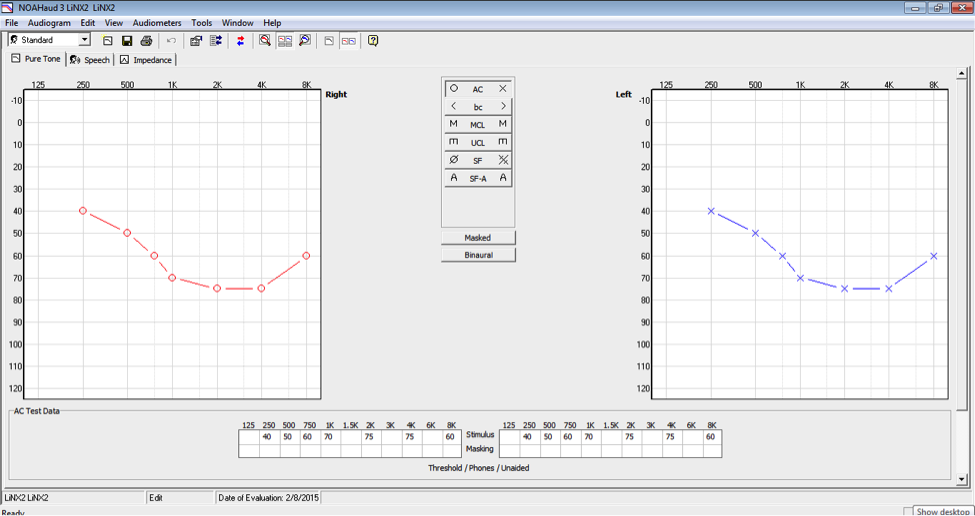Question
How does ReSound Aventa prescribe MPO and what is the rationale?
Answer
Historically, maximum power output (MPO) values visible in the Fit screen of the ReSound Aventa fitting software reflected maximum output for the hearing aid when set to full on gain. MPO values were not prescribed for the individual because the ReSound fast-acting WDRC minimizes the risk that uncomfortable loudness levels will be exceeded. With this type of system, the hearing aid may never produce uncomfortable sounds for any input level that the user is likely to encounter (Dillon, 2012). However, displaying the MPO values reflective of full on gain settings could be misleading, as the clinician saw MPO values that were not indicative of the output levels to which the patient might actually be exposed. In addition, the introduction of linear and semilinear amplification modes, as well as slower time constant options, increased the risk of patients experiencing louder levels. The strategy for MPO settings in Aventa software were thus updated for releases of Aventa 3.8 and later.
In order to make this feature more user-friendly and to take new amplification related features into account, Aventa now displays the MPO prescription specific to each patient’s fitting. The MPO values that will be seen by the clinician in the software are impacted by several factors, including the patient’s hearing thresholds, the hearing instrument being fitted, the coupler view used in the software, and the selected fitting prescription.
Let’s begin with an example. The following hearing thresholds were entered into a patient profile in NOAH (Figure 1).

Figure 1. Audiogram in NOAH.
Fittings were created using this patient profile in Aventa 3.7 (Figure 2), and in a later version of Aventa (Figure 3). The hearing thresholds, insertion gain and hearing instruments were identical in both fittings. However, the MPO values differ between the software versions. This difference reflects changing the setting from maximum output for full on gain (v3.7) to a maximum output prescription for the individual (v3.8 and later).

Figure 2. Hearing instrument Fit screen in Aventa 3.7. Note the MPO values reflect maximum output at full on gain settings. Therefore, they vary depending on the specific device being fit.

Figure 3. Hearing instrument Fit screen in Aventa 3.8 and later. Note the MPO values reflect prescribed maximum output for the individual patient based on hearing threshold levels.
How do different fitting factors influence the MPO prescription?
1. Hearing thresholds. The MPO prescription in Aventa is calculated using the NAL-NL2 formula, which is based on the patient’s hearing threshold levels. Different hearing thresholds will result in different prescribed MPO values.
2. Hearing instrument. Depending on the hearing instrument used in the fitting, the MPO values viewed in the software may differ from the MPO prescription. If the prescribed MPO values are greater than the maximum output of the hearing instrument receiver, Aventa will display the lower MPO values constrained by the instrument receiver. This may be observed when the patient’s hearing thresholds are near the limits of the fitting range at one or more frequencies.
3. Coupler and stimulus view. The MPO values visible in the software will change depending on the coupler view chosen in the settings. As Coupler view is changed from insertion gain to 2cc coupler, for example, the displayed gain and MPO values will change accordingly. The assumed verification signal for the MPO is, however, always a pure tone at 90 dB SPL regardless of the selected view. This means that if “Speech-weighted” is selected instead of “Pure tone”, then the displayed gain values will change but the MPO values will not.
4. Individual UCL. The way Aventa handles individually measured UCL values has not changed from previous versions of the software. If UCLs are measured for a patient and entered into the software, they will influence gain for 80dB inputs when the proprietary Audiogram+ fitting rule is selected. The MPO prescription will not change, but output for loud sounds will be affected by the change in G80 gain. For third-party prescriptions, whether or not individually measured UCL is taken into account depends on the particular formula. NAL-NL2 (which also provides the MPO prescription when Audiogram+ is selected) does not take individually measured UCL into account when prescribing MPO. See Dillon (2012)1 for a discussion of the rationale for this.
5. Fitting prescription. MPO values are prescribed for each patient based on the NAL-NL2 formula, unless the selected fitting formula contains its own MPO prescription. In that case, the MPO values for the selected prescription are used. This would include DSLv5 for adults and for pediatrics.
The MPO prescribed values are not targets. They are levels that the output should never exceed in order to ensure patient comfort. The actual output of the hearing aid for any given input level still depends on the gain. Therefore, when verifying MPO, it will be common to see output levels that are well under the prescribed levels.
A remaining question that frequently arises is whether to lower the MPO when the patient says the sound is too loud. Clinicians are rightly concerned about ensuring the safety and comfort of their patients in the presence of loud sounds, and it is common only to focus on the acceptable maximum settings. It might be tempting to lower MPOs from the prescribed level whenever the patient complains of the sound being too loud. However, it is also important to remember that the MPO should not be set too low, and that overall loudness complaints often are due to the gain settings rather than the MPO. The MPO is not like the feature in music players where it is possible to limit the volume to avoid hearing damage. Output limiting uses either a very high amount of compression, peak clipping, or some combination of the two to ensure that sounds above a certain level are not emitted by the receiver. This is very different than limiting volume (gain) in that it necessarily distorts the output signal when the limit is reached. This is almost always undesirable so it is also a goal of the MPO prescription to prevent the hearing aid from operating in saturation to the degree possible. Just as there is an acceptable maximum power output level, there is also a minimum acceptable power output level that will maintain good sound quality for speech and other everyday sounds. In validating the National Acoustic Laboratory’s approach to prescribing MPO, Storey and colleagues (1998) investigated the range of acceptable settings for MPO and found that it was influenced by the type of sound as well as the type of output limiting. Generally speaking, the upper limits – or the highest acceptable values the MPO could be set to – were not different for peak clipping versus compression limiting, but higher settings were accepted for impulse sounds than speech. Minimum levels were most affected by limiting type, with lower levels being acceptable for compression limiting. Based on this data as well as clinical experience, ReSound recommends keeping the channel specific MPO settings at 95 dB SPL or above if possible. The more severe the hearing loss, the trickier it becomes to balance audibility and comfort while avoiding too-frequent saturation of the hearing aid. The sound quality complaints that can lead the clinician to suspect too low MPO levels are “choppy” sound quality and sometimes the perception of cutting out by the hearing aid.
References
Dillon, H. (2012). Hearing aids. Thieme: New York.
Storey, L., Dillon, H., Yeend, I., & Wigney, D. (1998). The National Acoustic Laboratory’s procedure for selecting the saturation sound pressure level of hearing aids: Experimental validation. Ear & Hearing, 19(7), 267-279.


